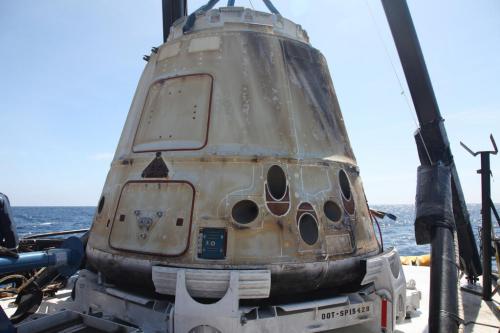New Details on SpaceX Plans Emerge
The CRS-2 Dragon spacecraft, pictured shortly after recovery, was returned to port in Los Angeles at approximately 7:00 PM PT, Tuesday evening. As it turned out, the craft ended up returning a more substantial payload than anticipated, a total of 3,256 lbs, 200 more than planned. Details of the return, and the thruster problem which threatened the mission early on were revealed in a Thursday afternoon press conference which included NASA administrator Charles Bolden, Julie Robinson, ISS Program Scientist, SpaceX President Gwynne Shotwell and company founder and chief designer Elon Musk.
According to Musk, the problem with pressurizing the Dragon’s Draco thrusters stemmed from an almost undetectable change by a vendor in the specifications of a helium check valve on the oxidizer tank. Prior to launch, SpaceX had tested the system at low, but not at high pressure, inadvertently allowing the change to pass unnoticed. Once the problem manifested itself in orbit, SpaceX software engineers began writing new code to permit a series of pressure cycles to free the stuck valve, racing against the clock to head off orbital decay. With critical, but somewhat unspecified assistance from the U.S. Air Force, (presumably its superior communications capacity) SpaceX uploaded the new software, ultimately bringing all the thrusters on-line and saving the mission.
Now having completed 3 missions in 10 months, included the latest which set a new Dragon record of 23 days in orbit and was the first to see use of the spacecraft’s trunk, attention is turning to two major technology development efforts. Staying with the Dragon theme for a moment, Elon Musk suggested that his company is working on a public rollout ceremony for the new Dragon 2.0 to take place, possible with NASA participation, this summer. SpaceX has taken pains to point out that the final design of the new, crew capable Dragon, also called DragonRider, will differ considerably from images and mockups released so far. Apparently, whenever it is unveiled, the public can expect to see a significant profile change with the inclusion of the side mounted escape and propulsive landing thrusters, deployable landing gear and larger windows. Or as Musk put it, something which looks like “a real alien spaceship.” With a pad abort test planned for the end of this year as part of its Commercial Crew Integrated Capacity (CCiCap) milestones, at a time when rival Boeing is still only conducting design reviews, SpaceX is poised to open up a runaway lead in the high stakes competition.
If there is one significant area of vulnerability, it almost certainly lies in the unknowns of introducing a significantly upgraded launch vehicle, which is the immediate task in front of SpaceX as it prepares for the maiden launch of the Falcon 9 V1.1 out of Vandenberg this summer. In addition to the flight debut of the Merlin 1D which has already seen service as the powerplant for the Grasshopper test bed, the upgraded Falcon 9 will now be fully triple redundant, as well as contain enhanced engine pod protection to safeguard craft and crew against any reoccurrence of the type of engine failure which occurred on the CRS-1 flight. In a related note, SpaceX President Gwynne Shotwell pointed out during the pre-flight press conference that, without going into specific details, the new Merlin 1D would be highly resistant to the type of problem which occurred on the previous flight. Note: For anyone still concerned about the 9 engine first stage, particularly where it concerns crew, please take another look at the rollout photo of the Soyuz booster which launched Expedition 35 to ISS yesterday and count the total number of first stage thrust chambers (32).
Apparently, based on comments made in yesterday’s press conference, SpaceX is not going to be wasting much time in pursuing its long-held quest for first stage re-usability. Beginning with this year’s Merlin 1D powered launches, the company will follow a gradual program of attempting to assert control over the vehicle’s ballistically arcing first stage, slowing it down before it re-enters the atmosphere with a re-ignition and burn of the center mounted engine leading to controlled water entry. Later efforts will include a second burn to slow the stage sufficiently to allow for touchdown on land. While the general approach to stage recovery has been public since the announcement of the Grasshopper in 2011, it came as a bit of a surprise that although as Elon Musk pointed out, SpaceX expects many failures along the way, there is a legitimate prospect of a return to launch site capability as early as next year.
Even if takes longer than that, with a large and steadily growing manifest, which presently includes roughly 40 launches, any mission which does not max out the new Falcon 9’s lift capacity presents another opportunity to continue to refine the procedure, with SpaceX free to experiment after the second stage has separated and is safely on its way to space. At this point, and considering progress to date, there is arguably a lot more reason to expect the effort achieve success somewhere within that 40 launch manifest than not. If they do, every changes.
In the meantime, with news of defense cutbacks and the impacts of sequestration, which Administrator Bolden pointed out yesterday is a 10 year program, presented in dire tones almost daily, why exactly is it that United Launch Alliance, utterly uncompetitive on the commercial market, and with no meaningful program of technology improvement remotely on par with that being undertaken by SpaceX, still enjoys a competition-free firewall around 80% of its business, and worse, much worse, is still receiving an annual launch subsidy ranging between $500 million and $1 billion per year?



Slight correction. It was a helium purge check valve that was the culprit with the Dragon’s thruster issue.
Clarification noted. Thank you